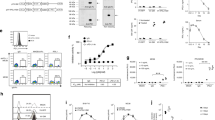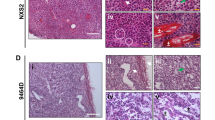Abstract
Modalities that act through different mechanisms can often provide synergistic antitumor activity for the treatment of refractory tumors when used in combination. Here we report a gene therapy approach in which the genes for the angiogenesis inhibitor, endostatin, and the marker protein and potent immunogen, green fluorescent protein (GFP), were delivered to murine neuroblastoma cells prior to inoculation of the tumor cells into syngeneic immunocompetent mice. Although the effect of either angiogenesis inhibition or immunomodulation alone resulted in only a modest delay in tumor growth, when these approaches were used in combination, prevention of the formation of appreciable tumors was effected in 15 of 24 (63%) mice. The combination of endostatin and GFP expression elicited a strong immune response that was T cell–mediated and was reactive against both GFP and tumor cell line–specific antigens. This afforded treated mice protection against subsequent tumor challenge with unmodified tumor cells. These results suggest that antiangiogenic and immunotherapy strategies, when used in a gene therapy–mediated approach, can act synergistically in an effective multimodality anticancer approach. Cancer Gene Therapy (2001) 8, 537–545
This is a preview of subscription content, access via your institution
Access options
Subscribe to this journal
Receive 12 print issues and online access
$259.00 per year
only $21.58 per issue
Buy this article
- Purchase on Springer Link
- Instant access to full article PDF
Prices may be subject to local taxes which are calculated during checkout
Similar content being viewed by others
References
Folkman J . The role of angiogenesis in tumor growth Semin Cancer Biol 1992 3: 65–71
Bicknell R, Harris AL . Mechanisms and therapeutic implications of angiogenesis Curr Opin Oncol 1996 8: 60–65
Pluda JM . Tumor-associated angiogenesis: mechanisms, clinical implications, and therapeutic strategies Semin Oncol 1997 24: 203–218
Folkman J, Ingber D . Inhibition of angiogenesis Semin Cancer Biol 1992 3: 89–96
Bicknell R, Harris AL . Anticancer strategies involving the vasculature: vascular targeting and the inhibition of angiogenesis Semin Cancer Biol 1992 3: 399–407
Scott PAE, Harris AL . Current approaches to targeting cancer using antiangiogenesis therapies Cancer Treat Rev 1994 20: 393–412
O'Reilly MS, Boehm T, Shing Y, et al . Endostatin: an endogenous inhibitor of angiogenesis and tumor growth Cell 1997 88: 277–285
Dhanabal M, Ramchandran R, Waterman MJF, et al . Endostatin induces endothelial cell apoptosis J Biol Chem 1999 274: 11721–11726
Dhanabal M, Ramchandran R, Ruediger V, et al . Endostatin: yeast production, mutants, and antitumor effect in renal cell carcinoma Cancer Res 2000 59: 189–197
Perletti G, Concari P, Giardini R, et al . Antitumor activity of endostatin against carcinogen-induced rat primary mammary tumors Cancer Res 2000 60: 1793–1796
Boehm T, Folkman J, Browder T, et al . Antiangiogenic therapy of experimental cancer does not induce acquired drug resistance Nature 1997 390: 404–407
O'Reilly MS, Holmgren L, Chen C, et al . Angiostatin induces and sustains dormancy of human primary tumors in mice Nat Med 1996 2: 689–692
Weber JS, Jay G, Tanaka K, et al . Immunotherapy of a murine tumor with interleukin-2 J Exp Med 1987 166: 1716–1733
Lord EM, Frelinger JG . Tumor immunotherapy: cytokines and antigen presentation Cancer Immunol Immunother 1998 46: 75–81
Cheung NK . Immunotherapy. Neuroblastoma as a model Pediatr Clin North Am 1991 38: 425–441
Hock RA, Reynolds BD, Tucker-McClung CL, et al . Human class II major histocompatibility complex gene transfer into murine neuroblastoma leads to loss of tumorigenicity, immunity against subsequent tumor challenge, and elimination of microscopic preestablished tumors J Immunother 1995 17: 12–18
Greten TF, Jaffee EM . Cancer vaccines Blood 1999 17: 1047–1060
Stripecke R, Villacres MdC, Skelton DC, et al . Immune response to green fluorescent protein: implications for gene therapy Gene Ther 1999 6: 1305–1312
Lode HN, Xiang R, Varki NM, et al . Targeted interleukin-2 therapy for spontaneous neuroblastoma metastases to bone marrow J Natl Cancer Inst 1997 98: 1586–1594
Dubridge RB, Tang P, Hsia HC, et al . Analysis of mutation in human cells by using an Epstein-Barr virus shuttle system Mol Cell Biol 1987 7: 739–745
Rehn M, Pihlajaniemi T . Identification of three N-terminal ends of type XVIII collagen chains and tissue-specific differences in the expression of the corresponding transcripts J Biol Chem 1995 270,9: 4705–4711
Smith TAG, Mehaffey MG, Kayda BD, et al . Adenovirus-mediated expression of therapeutic plasma levels of human factor IX in mice Nat Genet 1993 5: 397–402
Persons DA, Allay JA, Allay ER, et al . Enforced expression of the GATA-2 transcription factor blocks normal hematopoiesis Blood 1999 93: 488–499
Migita M, Medin JA, Pawliuk R, et al . Selection of transduced CD34 + progenitors and enzymatic correction of cells from Gaucher patients, with bicistronic vectors Proc Natl Acad Sci USA 1995 92: 12075–12080
Skidgel RA, Erdos EG . Cellular carboxypeptidases Immunol Rev 1998 161: 129–141
Persons DA, Mehaffey MG, Kaleko M, et al . An improved method for generating retroviral producer clones for vectors lacking a selectable marker gene Blood Cells, Mol, Dis 1998 24: 167–182
Yang Y, Vanin EF, Whitt MA, et al . Inducible, high-level production of infectious murine leukemia retroviral vector particles pseudotyped with vesicular stomatitis Virus G envelope protein Hum Gene Ther 1995 6: 1203–1213
Sarmiento M, Glasebrook AL, Fitch FW . IgG or IgM monoclonal antibodies reactive with different determinants on the molecular complex bearing Lyt 2 antigen block T cell-mediated cytolysis in the absence of complement J Immunol 1980 125: 2665–2672
Dialynas DP, Quan ZS, Wall KA, et al . Characterization of the murine T-cell surface molecule, designated L3T4, identified by monoclonal antibody GK1.5: similarity of L3T4 to the human Leu-3/T4 molecule J Immunol 1983 131: 2445–2451
Yamaguchi N, Anand-Apte B, Lee M, et al . Endostatin inhibits VEGF-induced endothelial cell migration and tumor growth independently of zinc binding EMBO J 1999 16: 4414–4423
Yoon SS, Eto H, Lin C, et al . Mouse endostatin inhibits the formation of lung and liver metastases Cancer Res 1999 59: 6251–6256
Blezinger P, Wang J, Gondo M, et al . Systemic inhibition of tumor growth and tumor metastases by intramuscular administration of the endostatin gene Nat Biotechnol 1999 17: 343–348
Sauter BV, Martinet O, Zhang WJ, et al . Adenovirus-mediated gene transfer of endostatin in vivo results in high level of transgene expression and inhibition of tumor growth and metastases Proc Natl Acad Sci USA 2000 97: 4802–4807
Feldman AL, Restifo NP, Alexander R, et al . Antiangiogenic gene therapy of cancer utilizing a recombinant adenovirus to elevate systemic endostatin levels in mice Cancer Res 2000 60: 1503–1506
Acknowledgements
This work was supported by grants from the Assisi Foundation of Memphis 94-000, Grant IRG-87-008-09 from the American Cancer Society, Cancer Center Support CORE Grant P30 CA 21765, and American Lebanese Syrian Associated Charities.
Author information
Authors and Affiliations
Corresponding author
Rights and permissions
About this article
Cite this article
Davidoff, A., Leary, M., Ng, C. et al. Autocrine expression of both endostatin and green fluorescent protein provides a synergistic antitumor effect in a murine neuroblastoma model. Cancer Gene Ther 8, 537–545 (2001). https://doi.org/10.1038/sj.cgt.7700346
Received:
Published:
Issue Date:
DOI: https://doi.org/10.1038/sj.cgt.7700346
Keywords
This article is cited by
-
Endothelial progenitor cell: a blood cell by many other names may serve similar functions
Journal of Molecular Medicine (2013)
-
Endostatin inhibits lymph node metastasis by a down-regulation of the vascular endothelial growth factor C expression in tumor cells
Clinical & Experimental Metastasis (2005)



